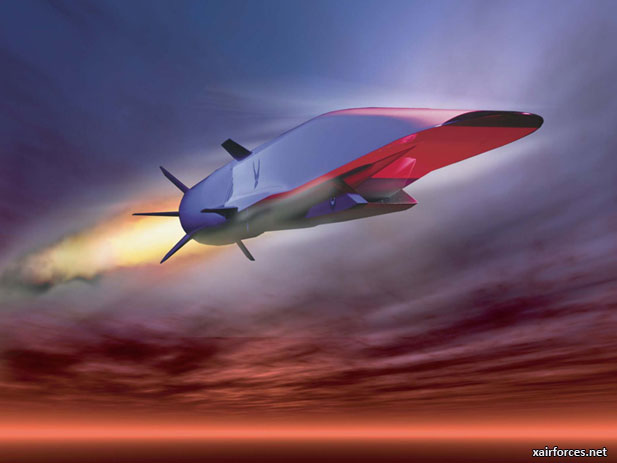
Imagine flying from New York to London in under an hour

Perhaps Han Solo said it best in Star Wars when, describing his hyper-fast smuggling spaceship the Millennium Falcon, he said, "It may not look like much, but it's got it where it counts."
While the Air Force might take exception to being likened to the Falcon, in reality the platypus-nosed X-51A Waverider hypersonic flight test vehicle really doesn't look like much. But it definitely has it where it counts.
On Tuesday, the unmanned 25-foot-long vehicle will be dropped off of the wing of a converted B-52 bomber off the California coast and try to fly for 300 seconds at science fiction-like speeds of Mach 6, over 4,500 mph - fast enough to fly from New York to London in less than an hour.
It is the Pentagon's latest test as it studies the possibilities of hypersonic flight, defined as moving at speeds of Mach 5 (about 3,400 mph) and above without leaving the atmosphere. The technology could eventually bring missiles or airplanes to the other side of the planet in minutes instead of hours.
The Air Force and the Pentagon are not saying much about Tuesday's test, but the military could use such technology for reconnaissance aircraft, cruise missile-like weapons or vehicles that could carry people or cargo so fast adversaries would not have time to react, according to military analysts.
The Air Force conceived the X-51A program in 2004 and, according to the military analysis website Globalsecurity.org, the service has spent $140 million on the Waverider system. The Air Force will not disclose the actual cost of the program.
Long like a missile and with just a few fins in the rear, the Boeing-built aircraft is not designed as a bed for a weapon, according to the Air Force, but it is testing the technology to build future weapons around.
Past Waverider flights have come with mixed results. In May 2010, the Waverider made its first flight at 3,500 mph for 143 seconds before a malfunction caused the test to shut down early.
A June 2011 test also was shutdown early but did collect some data for the Air Force.
If all goes as planned, the flight Tuesday will end with a dive into the Pacific; there is no intent to recover the aircraft. The Air Force says the program was designed for each vehicle to be destroyed at the end of its flight test because of the cost that would be involved in recovering them. Data is fed back to evaluators during the test.
The Pentagon considers hypersonic flight the new stealth. The technology could move reconnaissance or bomber aircraft at high altitudes and speeds that put them far out of the reach of surface-to-air missiles or other anti-aircraft fire. The kind of speeds the X-51A is able to reach cannot be achieved with current jet-powered technology.
The aircraft uses "scramjet" technology, an engine with virtually no moving parts. It uses oxygen from the atmosphere for its engines, as opposed to carrying large fuel tanks that rockets require, making it a more efficient vehicle for military or commercial purposes.
Additionally, because of the high speeds the vehicle is also able to ride on the shockwave it creates at six times the speed of sound, increasing efficiency, according to an Air Force factsheet on the X-51A. It says that is also the genesis of the vehicle's nickname, the Waverider.
The Pentagon's high-technology research group, the Defense Advanced Research Projects Agency, or DARPA, says getting aircraft to speeds of Mach 20 - which would enable the military to get anywhere in the world in under an hour - is an area of research where significant scientific advancements have eluded researchers for decades.
The Pentagon says it is studying this technology as countries have made advances in thwarting stealth technologies the U.S military has in its arsenal.
"That strategic advantage is threatened as other nations' abilities in stealth and counter-stealth improve," according to DARPA website. "Restoring that battle space advantage requires advanced speed, reach and range. Hypersonic technologies have the potential to provide the dominance once afforded by stealth to support a range of varied future national security missions."
The military could use it in two realms, according to Dan Wasserbly, the Americas editor of IHS/Jane's, a military analysis publication.
"They could use it to develop cruise missile-like weapons that could reach a target on the other side of the planet in minutes instead of hours, as well as developing aircraft which could put a quick-reaction force on a far-off battleground within hours instead of days," Wasserbly said.
The Air Force has said that by 2016 it would like to have a working weapon flying with hypersonic technology. But with the program budgeted only though this Tuesday's test, it is unclear when anything with hypersonic technology could be fielded, according to Wasserbly.
The Air Force made four of the X-51A test vehicles. Tuesday's test will be the third and possibly last test, according to Air Force spokesman Daryl Mayer.
"The Air Force will review the data from this mission and assess what will come next," he said.
The Pentagon has also been studying other hypersonic technology, including 2010 and 2011 flight tests of the Falcon Hypersonic Test Vehicle (HTV-2) capable of reaching Mach 20, approximately 13,000 mph, according to DARPA.
Both of those tests ended with the aircraft crashing before the tests were complete.
So even after the Air Force evaluates the results of the Tuesday test, it will be hard to know when the military will start launching troops from the U.S. to a far-flung combat zone in minutes.
Source: By Mike Mount, CNN Senior National Security Producer - 14 August 2012 (CNN News)
Photo: The U.S.A. Air Force Hypersonic X-51A Waverider Scramjet (Photo by NASA)
(14.08.2012)
|